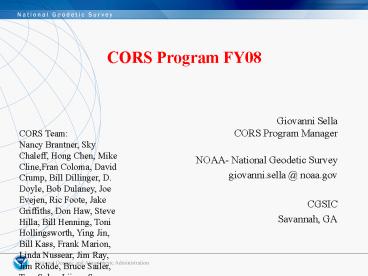CORS Program FY08 PowerPoint PPT Presentation
1 / 14
Title: CORS Program FY08
1
CORS Program FY08
Giovanni Sella CORS Program Manager NOAA-
National Geodetic Survey giovanni.sella _at_
noaa.gov CGSIC Savannah, GA
CORS Team Nancy Brantner, Sky Chaleff, Hong
Chen, Mike Cline,Fran Coloma, David Crump, Bill
Dillinger, D. Doyle, Bob Dulaney, Joe Evejen, Ric
Foote, Jake Griffiths, Don Haw, Steve Hilla, Bill
Henning, Toni Hollingsworth, Ying Jin, Bill Kass,
Frank Marion, Linda Nussear, Jim Ray, Jim Rohde,
Bruce Sailer, Tom Soler, Lijuan Sun, Neil Weston
2
What is CORS?
- A number of products and services that directly
support NGSs mission - Defining, maintaining and providing access to
the National - Spatial Reference System (NSRS) for the
civilian sector of - the US government.
- How
- Each CORS station provides the most basic
information (code and phase data) needed to
calculate its coordinate and velocity. The
relationship of the coordinates and velocities at
CORS with the International Terrestrial Reference
Frame (ITRF) is used to define the geometric
component of the NSRS (lat, lon, ellip. ht). - Collect data, calculate orbits, coordinates
velocities, establish guidelines, provide
post-processing applications, provide training
3
CORS September 2008
CORS 1250 Stations This year added 270
4
CORS Partners
- CORS is gt 98 volunteer (non-NGS)
5
CORS Activities FY 2008
- NGS GPS orbits reach 1 cm-level
- NGS is the IGS Analysis Center Coordinator. IGS
orbit products (4yr term). - HTDP 3.0 released especially important for the
for the western US - Re-analysis of all CORS data and orbits 1994-to
date started - Prototype CORS-realtime service operational (next
talk by B. Henning) - Added 270 stations 3x as many as last year
- Antenna calibration transition from relative to
absolute is starting - OPUS-RS 65 increase in use
- OPUS-DB is an operational prototype
- Established 4 CORS in Ethiopia to support USAID
- Supporting new CORS in Iraq and Afghanistan
6
Key Issues Facing CORS
- Maintain and improve the NSRS (geometric
component) - Keep it consistent with the ITRF
- Support current CORS and add new CORS
- Streamline current data ingestion and computation
- Add new products
- Real time activities, GNSS
7
Maintaining/Improving the NSRS
- Upgraded PAGES software and overhauled methods
for computing coordinates and aligning them with
ITRF (2.5 years) - WHY
- Existing coordinates/plots are not consistent
with the latest ITRF - Processing software needed to conform to IERS
standards/models - Resolve the discrepancy in scale between VLBI and
GPS. Mostly resolved by changing from relative
to absolute antenna calibrations. - Simplify and improve NGSs coordinate and
velocity calculations and ensure alignment with
ITRF is easier and more robust. - HOW
- Recalculate orbits and coordinates for all CORS
using new orbits from 1994-current (will require
2 yrs). - Begin discussion on how to define the next NSRS
(geometric i.e. NAD83) and reconcile with
previous ones.
8
Support Current CORS and Add New CORSmeta data
are AS IMPORTANT as the data
- WHY
- Continue to have a number of internal
software/hardware and network problems. Very
serious problem mid-May to mid-July on
distribution server in SS. - WHAT
- Continued improving data ingestion and associated
alternate facility in Boulder. - Updated/restructured hardware to accommodate
re-analysis and improve data storage (much more
needs to be replaced). - Numerous additional steps to be taken.
- Added 270 stations to the network.
- Merge COOP CORS with National CORS in accordance
with the 10 year plan - New CORS must conform with guidelines
- www.ngs.noaa.gov/CORS/Establish_Operate_CORS.htm
l
9
Supporting New Products
- Real time - essential that CORS/NGS supports
this activity.(Next Henning)
GNSS add GLONASS and new GPS frequencies to
online storage in 2009
GNSS sites
10
OPUS (Online Positioning User Service)
- OPUS - A collection of web services
- OPUS-S (static) what was called OPUS
- OPUS-RS (rapid static) 65 increase in number of
users compared to last year. - OPUS-DB currently available as operational
prototype - Other OPUS flavors under consideration
development (NO timeline) - OPUS-Mapper (single frequency)
- OPUS-Projects (multiple sites all adjusted
simultaneously)
11
OPUS (Online Positioning User Service)
combined
12
Horizontal Time-Dependent Positioning (HTDP)
- Applications
- Predict velocities
- Predict displacements
- Update positions
- Update observations
- Transform positions between reference frames
- Transform velocities between reference frames
- New in HTDP 3.0
- Introduced new model for crustal velocities in
western CONUS - Introduced a model for the motion associated with
2002 Denali earthquake in Alaska
13
Updated model for crustal velocities
- An analytical model representing horizontal
crustal motion was developed by Dr. Robert
McCaffrey using DEFNODE - - Incorporates all major active faults in a
single model. - Input data include
- - 4,890 GPS-derived velocities
- - 170 fault slip rates from paleoseismic
paleomagnetic studies - - 258 fault slip vectors taken from earthquakes
and geologic studies
14
Plans for FY 2009
- Complete all of re-analysis of orbits and get
more than 50 of all CORS data - Plan for new NSRS
- Storing and distributing GNSS data
- Start work on HTDP for Alaska
- Continue to work with our partners to improve
existing stations and add new ones - Continue major overhaul of data management tools
to improve coordinate computation - Making UFCORS and OPUS available from Boulder as
alternate location - Socio-economic valuation of the CORS program

